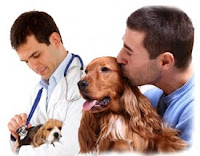 When looking for a veterinarian, your pet's care is of utmost importance. So don't leave your prized pooch to just anyone. We have compiled what we feel are the most important considerations when seeking a new vet, and hope that you will consult this guide whenever you are on the hunt for great veterinary care.
When looking for a veterinarian, your pet's care is of utmost importance. So don't leave your prized pooch to just anyone. We have compiled what we feel are the most important considerations when seeking a new vet, and hope that you will consult this guide whenever you are on the hunt for great veterinary care.Determination.
Before starting your search, make a list of your pet's particular needs. What species and breed is s/he? Does your pet have any special health concerns which require specialization? Does your pet respond better to female vets? These questions and others will help you to determine the right type of veterinarian for your pet and will simplify the next phase of your search.
Location.
Unless your pet requires a specialist, it's wise to choose a veterinarian who lives close to your home. Consider distance and road conditions during bad weather or emergencies. You want to be able to get your pet to his or her veterinarian as quickly and safely as possible.
Reputation.
As a pet owner, you have several resources for finding the perfect vet for your furry friend. The first is The American Animal Hospital Association. This organization evaluates veterinary practices on the quality of their facilities, staff, equipment and patient care. You can search their website for a list of accredited vets in your area. An equally good method of finding a veterinarian is to ask for recommendations from friends, family or neighbors whose pet care opinions you trust. Finally, if you are new to the area, you can also search the Yellowpages for a complete list of local veterinarians that match your pet's needs and your personal preferences.
Inspection.
Once you have narrowed your list down to a handful of veterinarians or practices, arrange to tour the facility. You should look for:
- A clean, modern and well-organized space
- Dog and cat cages kept in separate areas
- Caring, calm, competent and courteous vets/staff who communicate effectively
- Convenient parking
You should ask:
- Is the practice AAHA-accredited?
- How many veterinarians are there in the practice?
- Are there technicians or other professional staff members?
- Do the veterinarians have special areas of expertise?
- Will vet(s) refer patients to specialists?
- What sort of equipment is used?
- Are X-rays, ultrasounds, blood work, EKGs, endoscopy and other diagnostic procedures performed in-house or referred to a specialist?
- What are the pre and post-procedures for surgery?
- What is the protocol for pain management?
- How are overnight patients monitored?
- What are the fees, and are there discounts for multi-pet households or senior citizens?
And trust your instinct. If it feels wrong, it probably is (and visa versa). Make your decision knowing that you can always find a new veterinarian if you or your pet is unhappy.
Adoption.
If things start out on the right foot with your newly "adopted" veterinarian, great! Keep up the good work. If not, remember to first give your new veterinarian a chance by being a good pet owner...
- See your vet regularly for preventative visits (and be on time!), not just because he or she is ill. Diagnoses shouldn't (and usually can't) be made over the phone.
- Know what is normal health and behavior for your pet so that you will accurately recognize when they are ill.
- Take your pet to the vet at the first sign of illness.
- Bring dogs to the vet on-leash and cats in a carrier.
- Only call your vet during off-hours if it is an emergency.
- Call ahead in an emergency to let the vet and staff know you will be arriving, and accept that you may need to be referred to an emergency vet.
*Sources for portions of this post include The American Animal Hospital Association, ASPCA and Humane Society.













